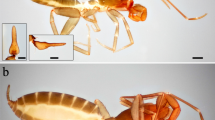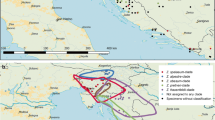Summary
A coding method for identifying individuals by utilizing natural attributes (numbers and disposition of arms, madrporites, anuses, spines and deformities) permits individual recognition of crown-of-thorns sea stars Acanthaster planci. Because natural injuries altering parts of the code are frequent in A. planci (present in 20% to 40% of the individuals in a population), the physiognomy of the centrally located periproct, which is much less frequently injured than peripherally located areas, was used in combination with the arrangement of arms and madreporites. Identical madreporite/arm codes occurred in fewer sea stars in Guam (0%) than in Panamá (14%). The greater variability among sea stars at the western Pacific locality could be due in part to the higher incidence of gross deformities (presumed injuries) in Guam (43%) compared with Panamá (17%).
Similar content being viewed by others
References
Aziz A, Sukarno (1977) Preliminary observation on living habits of Acanthaster planci (Linnaeus) at Pulau Tikus, Seribu Islands. Mar Res Indonesia 17:121–132
Barham EG, Gowdy RW, Wolfson FH (1973) Acanthaster (Echinodermata, Asteroidea) in the Gulf of California. Fish Bull 71:927–942
chesher RH (1969) Acanthaster planci: impact on Pacific coral reefs. Westinghouse Elect Corp Rep to US Dept Interior, Doc No PB187631
Daniel WW (1978) Applied nonparametric statistics. Houghton Mifflin Co, Boston
Endean R (1973) Population explosions of Acanthaster planci and associated destruction of hermatypic corals in the Indo-West Pacific region. In: Jones OA, Endean R (eds) Biology and geology of coral reefs, vol 2, biology 1. Academic Press, New York, pp 389–438
Endean R, Chesher RH (1973) Temporal and spatial distribution of Acanthaster planci population explosions in the Indo-West Pacific region. Biol Conserv 5:87–95
Glynn PW (1974) The impact of Acanthaster on corals and coral reefs in the eastern Pacific. Environ Conser 1:295–304
Glynn PW (1982) Acanthaster population regulation by a shrimp and a worm. Proc. 4th Int. Coral Reef Symp., 1981 (in press)
Hubbs CL, Roden GI (1964) Oceanography and marine life along the Pacific coast of Middle America. In: West RC (ed) Natural environment and early cultures, vol 1. Handbook of Middle American Indians. University of Texas Press, Austin, pp 143–186
Hyman LH (1955) The invertebrates, Echinodermata, vol 4. McGraw-Hill Book Co, New York
Kvalvågnaes K (1972) Tagging of the starfish, Asterias rubens L. Sarsia 49:81–88
Lehner PN (1979) Handbook of ethological methods. Garland STPM Press, New York
Lucas JS (1975) Environmental influences on the early development of Acanthaster planci (L). Crown-of-thorns starfish seminar proceedings, Australian Government Publishing Service, Canberra, pp 109–121
Ogg JG, Koslow JA (1978) The impact of Typhoon Pamela (1976) on Guam's coral reefs and beaches. Pacif Sci 32:105–118
Ormond RFG, Campbell AC (1974) Formation and breakdown of Acanthaster planci aggregations in the Red Sea. Proc Second Int Coral Reef Symp Great Barrier Reef Committee, Brisbane, 1:595–619
Ormond RFG, Campbell AC, Head SH, Moore RJ, Rainbow PR, Saunders AP (1973) Formation and breakdown of aggregations of the crown of thorns starfish, Acanthaster planci (L). Nature 246:167–169
Sebens KP (1976) Individual marking of soft-bodied intertidal invertebrates in situ: a vital stain technique applied to the sea anemone, Anthopleura xanthogrammica. J Fish Res Bd Canada 33:1407–1410
Vermeij GJ (1978) Biography and adaptation: patterns of marine life. Harvard University Press, Cambridge, Mass
Vermeij GJ, Zipser E, Dudley EC (1980) Predation in time and space: peeling and drilling in terebrid gastropods. Paleobiology 6:352–364
Wiens HJ (1962) Atoll environment and ecology. Yale University Press New Haven
Wilson BR, Marsh LM (1975) Seasonal behaviour of a “normal” population of Acanthaster in western Australia. Crown-of-thorns starfish seminar proceedings, Brisbane 6 September 1974. Australian Government Publishing Service, Canberra, pp 167–179
Yamaguchi M (1973) Early life histories of coral reef asteroids, with speccial reference to Acanthaster planci (L). In: Jones OA, Endean R (eds) Biology and geology of coral reefs, vol 2, Biology 1. Academic Press, New York, pp 369–387
Yamaguchi M (1974) Growth of juvenile Acanthaster planci (L) in the laboratory. Pacif Sci 28:123–138
Author information
Authors and Affiliations
Rights and permissions
About this article
Cite this article
Glynn, P.W. Individual recognition and phenotypic variability in Acanthaster planci (Echinodermata: Asteroidea). Coral Reefs 1, 89–94 (1982). https://doi.org/10.1007/BF00301690
Received:
Accepted:
Issue Date:
DOI: https://doi.org/10.1007/BF00301690




